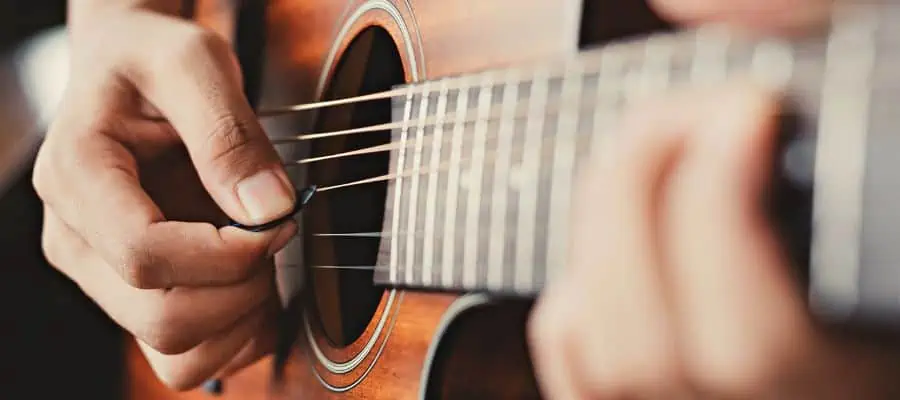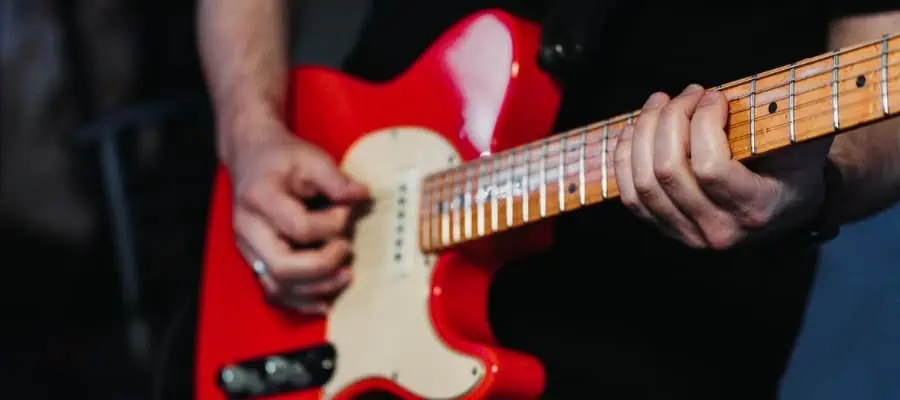All guitarists become subject to finger pain at some point in their journey, especially during those earlier phases when the skin is still unused to the repeated pressure. However, if your instrument comprises steel strings, it might seem like you have a particularly hard time dealing with the discomfort. So, why do steel strings hurt your fingers?
Steel strings hurt your fingers because they put a lot of pressure on your skin, creating friction and damaging the soft tissue covering your fingertips. When you press down on a string to fret a note, it’ll press right back against your fingers with force, causing pain, discomfort, and blisters.
If your guitar’s steel strings are causing you pain, and you’re looking for ways to get to the root of the issue and effectively solve it, you’ve come to the right place. Below, I’ll take you through how steel strings hurt your fingers, what gentler options you can opt for instead, and how to best protect your fingers as a guitar player, so make sure to read on until the end.
How Steel Strings Hurt Your Fingers

Steel strings hurt your fingers due to excessive pressure, friction, and tension. So, let’s discuss each of these issues separately.
Once you start using steel strings, you’ll first experience the pressure they put against your fingertips. As I mentioned above, when you press down on the metal to fret a note, it’ll press right back, causing discomfort and pain.
With enough repeated pressure, you’ll start to feel some friction. The surface of steel strings is rough, so they don’t simply slide through your fingers when you play. While this quality can be beneficial, considering that grip is important in a good performance, it can also make it more painful for you to withstand longer playing sessions.
Lastly, steel strings are usually under high tension, contributing to pain or discomfort. The higher the tension, the more force is required to press on the strings, and you go right back to the first element of this “pain trifecta” and enter a vicious cycle.
This cycle will continuously damage the soft tissue of your fingertips, removing your skin’s tougher exterior layers and exposing deeper, more nerve-dense ones. When these deeper layers experience pressure, friction, and tension, they’ll be much quicker to transmit the message to our brain, allowing us to feel pain.
While on this topic, I want to note that while some pain is normal, especially for beginners, extreme discomfort might be a sign of an underlying health issue, so if you feel like that’s you, it’s worth contacting your healthcare provider and asking for a more accurate diagnosis.
Now that you understand how steel strings hurt your fingers, it’s time to explore some potential solutions.
What String Materials Will Be Gentler on Your Skin?

The most straightforward solution would be to switch to strings made of gentler materials. While that wouldn’t solve the pain issue altogether, as beginners are bound to experience some discomfort no matter what type of strings they use, some materials can help alleviate it significantly.
Nylon strings, for example, are probably the best choice for sensitive fingers. That’s because they’re far smoother and less dense than their metal counterparts, thus applying less friction and pressure on your skin.
Other excellent options include coated and silk-steel guitar strings; however, since nylon is usually the most accessible and widely used material out of the three, that’s the one I’ll focus on in this section.
It’s important to note that because nylon strings are gentler on your skin, they’re not necessarily the best choice for everyone. That’s why I recommend making a thorough comparison before settling on what seems like the ideal material for you.
For example, while nylon strings provide a better feel and a sweet, mellow tone, they also have a limited tonal range and tend to stretch out as time goes by. So, it’s important to do your due diligence and set your priorities before deciding.
How To Protect Your Fingers From Guitar String Pain

With all that said, you need to remember that if you’re a beginner, you’re bound to experience finger paint as your skin gets used to the friction and your fingers get used to all the extra movement.
Luckily, there are several steps you can take to protect your fingers from string-related pain, so you can save yourself from that discomfort and make the learning process far more pleasant.
Here’s what you can do:
- Stretch your fingers before each playing session. Fingers work like any other muscle in your body – if you don’t properly warm them up before a rigorous training session, you’ll be much more likely to experience pain afterward.
- Take breaks during long playing sessions. While I understand that even newer players sometimes have to play for hours on end, that doesn’t mean you can’t take a break. Giving your fingers proper time to rest can make a world of difference.
- Use finger protectors. Though this is the most straightforward approach; however, they can dampen the overall playing experience, so it’s best to graduate out of them at some point so that you can start developing calluses.
- Practice good technique. Poor technique can be the main culprit behind finger pain, so I recommend either working with a guitar teacher continuously or, at least, occasionally meeting with one so that they can critique your form.
- Invest in a strap. Once that extra weight is taken off of your hands, your fingers will have a far easier time playing without excessive pressure being put into them. Moreover, ensure you get a guitar that fits your stature so you don’t have to contort your hand to play it.
Conclusion
Steel strings hurt your fingers because they apply excessive amounts of pressure, friction, and tension on your skin. However, as long as you use the proper technique and don’t have any underlying health conditions, the pain should subside as time goes on.
However, if you’re looking for a quicker solution, you can always opt for a softer string material like nylon. No matter what variety you ultimately choose, though, don’t forget to protect your fingers as best as you can by following the tips outlined above.
If you found this article useful, you may want to save this pin below to your Guitar board.

Recent Posts
Tuning your guitar to E Flat, also known as E♭ tuning or half-step-down tuning, involves lowering each string by a half step. This creates the notes E♭, A♭, D♭, G♭, B♭, E♭ or D#, G#,...
50 Campfire Guitar Songs To Ignite Your Next Singalong - Chords Included
Gathering around a crackling campfire with friends and a guitar is one of life's simpleest pleasures. Picture yourself strumming the chords as everyone belts out the chorus under a starry sky. From...

